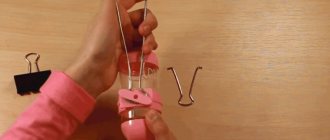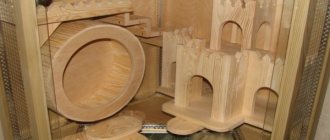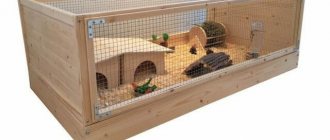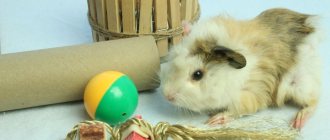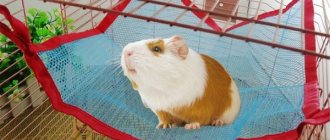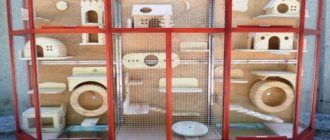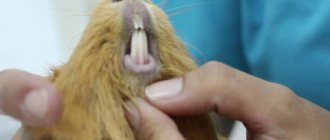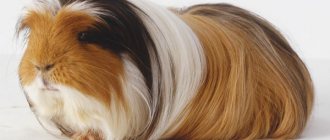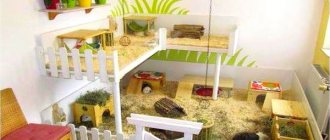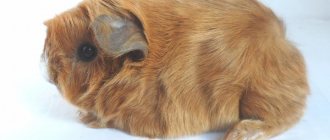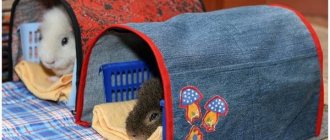Automatic sippy cups: ball and nipple
This is the most popular option and that is why there is such diversity among automatic waterers for hamsters.
The cost also varies greatly and depends on many factors (material, size, fastening). The cheapest automatic sippy cup with a ball can be found for 150 rubles, for a more modern, improved model you will have to pay more - up to 700 rubles. The flasks of such drinkers are made of plastic and glass, and the spouts are made of metal.
Sometimes they are additionally equipped with a float for better visibility of the level of remaining liquid. The mechanism can be ball or pin. There is no fundamental difference between them; if the animal is used to one, it will be able to use the other; both the ball and nipple drinkers work on the principle of a regular washstand.
When choosing, it is important to consider the preferred mounting method:
- if your pet’s habitat is a cage with vertical bars, then sippy cups with plastic or metal clamps are suitable;
- for a cage with horizontal bars, it is better to purchase a drinking bowl with a metal loop; it will be easy to hang in almost any convenient place;
- if the animal lives in a terrarium, then the choice should be made in favor of an automatic drinker with a suction cup, which can be easily attached to the glass.
The undeniable advantages of this type of drinkers include the possibility of attaching them outside the cage, long-term preservation of clean drinking water, and a metal spout that is resistant to rodent bites.
The only disadvantage of this type of sippy cups is the likelihood of a poor-quality purchase. Cheap automatic sippy cups often leak. If possible, while still in the store, ask the seller to check the product in front of you, because the cause of the leak may be a defect.
Sometimes the drinker leaks from under the lid; perhaps there is not enough rubber or silicone sealing ring under it, or it is not thick enough. But more often it drips from the spout of automatic sippy cups. This may occur due to the spout becoming clogged with sawdust or limescale deposits forming. Such contamination can be easily removed with cleaning agents. It happens that the leak is located in the area of the connection between the tube and the container. In this case, it will be enough to insert the spout deeper into the hole.
If for some reason you have not purchased a drinking bowl or like to make things, then you can make it yourself. You can read about this in the article “How to make a drinking bowl for a hamster.”
We encountered a problem - the hamster does not drink water. An article on how to train a hamster to drink from a drinking bowl will help solve this issue.
Don't want to buy a drinking bowl at the store or do you just like to make things? One way or another, we will try to help you and tell you how to make a drinking bowl for a hamster with your own hands at home. There is nothing complicated about it; the device can be made within five minutes. The main thing is to have the right materials in your home.
What to do if your guinea pig does not drink water from the drinking bowl
Sometimes a rodent will avoid using an intricate device. In this case, you need to act according to the situation.
Diseases
If a guinea pig does not drink water from the drinking bowl and refuses to eat, then there is a high probability of feeling unwell. Be sure to show your pet to the veterinarian.
Lack of experience due to age
If you have enough succulent food, you don’t have to worry about the baby’s health. An adult animal can act as a teacher, since rodents quickly absorb new information and love to imitate.
Disorientation in a new place
If your pet has changed its place of residence and is frantically poking around in search of water, then push it in the right direction and observe. With past experience, he will definitely take the right actions.
Sometimes you have to accustom your guinea pig to a new drinking bowl.
Changing the bowl to a ball sippy cup
You can teach a guinea pig to drink with a ball as an adult using your own example:
- demonstrate the drinking bowl and provide time for independent study (a smart animal often comes to independent conclusions);
- touch the ball with your finger, causing water to appear;
- bring a wet finger to the pig;
- repeat steps if necessary.
IMPORTANT! Stay hydrated. If the pet is weak and does not compensate for moisture with succulent food, then it will have to be given a drink by force, but without a drinking bowl. For such cases, a syringe filled with water is suitable.
What does a guinea pig need?
Rodents are unpretentious, but this does not mean that any living conditions are suitable for them. There are certain requirements for keeping animals at home, which relate not only to the home itself, but also to its equipment.
Cage or rack
To keep a guinea pig you need a cage. It should be spacious so that the animal does not live in cramped conditions. It is recommended to choose a cage equipped with a plastic tray - this design is much easier to clean.
You can save free space without reducing the space of the pig’s home using a two-story shelving cage. This option is also suitable if there is more than one animal.
If you were unable to find a suitable structure in a pet store or its cost does not fit into your budget, you can easily make both a cage and a rack yourself.
Aviary
If possible, it is worth purchasing or creating an enclosure for pigs with your own hands. The spaciousness of such a home is incomparable to any cage - freedom of movement for the animal is guaranteed. The enclosure can be divided into separate zones - catering unit, playroom, bedroom, etc.
Enclosures (wire or plastic) are also used for walking pigs outside during the warm season.
House
Regardless of what the main dwelling will be (cage, shelving or enclosure), you need to place a small house or other shelter inside it, where the animal can retire if desired. If the installed “shelter” has a flat roof, the pet will be able to use it as an observation tower - climbing onto the roof, it will observe from above what is happening around.
Filler
Filler plays an important role in maintaining cleanliness and comfortable conditions in your pet’s home. Recommended choices are corn pellets or sawdust. These fillers are characterized by high absorbency and safety for animals. It is worth noting that cat litter should not be used under any circumstances for pigs to live in.
Drinking bowl
During the day, rodents consume different amounts of drink - this is due to the content of juicy components in the daily food. Nevertheless, the drinking bowl with which you need to equip the animal’s home should always be filled with fresh water - filtered or clean boiled. As drinking bowls for guinea pigs, only hanging-type devices with a metal ball at the end are used.
Feeder
The pig's menu includes both dry and juicy ingredients. To prevent them from mixing, it is worth placing two bowls in your pet’s cage - pour grain mixtures or granulated food into one, and put berries, chopped vegetables and fruits into the other.
Both feeders must be stable, otherwise the rodent will overturn them. The animal can easily chew plastic bowls, so it is better to use feeders made of more reliable materials. Ceramic bowls work well - they are heavy and durable. You can also use metal ones, but to prevent the animal from knocking them over, you should attach them to the bars of the cage.
Hay holder
The pigs' diet is based on hay, so the animal should have a lot of it. To ensure that your pet always has access to hay, it is necessary to equip the cage with a special hay holder or hay rack. It is better to choose suspended structures - this will prevent animals from trampling or dirtying the hay.
Pet stores sell models of kennels made of metal and plastic. If desired, you can build a holder yourself from fabric, wood or plastic. The design is simple, the main thing is that the pet can freely remove bundles of hay from the holder.
Carrying
Fearfulness is one of the character traits of guinea pigs; they do not tolerate the road, unfamiliar places, etc. To minimize the stress of the rodent during transportation, you need to purchase a carrier for your guinea pig. It will be needed when delivering the animal home from the breeder or from the store, and subsequently to and from the veterinarian.
You can use an ordinary cardboard box with pre-made holes as a carrier so that your pet does not suffocate. But it’s better to immediately buy a real plastic carrier.
Wheel
This item is worth mentioning, as many believe that the pig needs it as well as the hamster. This judgment is wrong. Unlike dexterous hamsters, pigs are clumsy, their spine almost does not bend. The running wheel will not bring any benefit to the pig, rather the opposite - if the animal does not bypass the equipment, the contact will most likely result in the pet getting injured.
how to water a guinea pig
how to water a guinea pig ¶
From: Frenchi - November 15, 2007 11:48 am
We recently got a guinea pig. please tell me what kind of water should I drink, boiled or not. how often should she drink water. We are worried that the pig does not drink water at all (we have not seen it once for 3 days)
how to water a guinea pig ¶
From: Student - November 15, 2007 11:56
I give it boiled. In simply filtered water, microbes appear within an hour. It’s also better for people not to drink it. The pig may not drink if she has enough succulent food.
How to install a drinker correctly
The guinea pig sippy cup should first be checked for leaks before installation. To do this, you need to install the device outside the cage and vertically, and place a piece of paper under the drinking device. If after a few hours the paper remains dry, then the device is ready for use.
The sippy cup is installed outside the cage at a level at which it will be convenient for the pet to reach it. Usually this is 5–6 centimeters from the floor. It is necessary to check whether the pet has to reach for the drinking bowl. For fastening, use a piece of wire or rubber.
The drinking device is located in the animal’s feeding area. It is not recommended to install the device near a pet’s resting place, as animals are sensitive to sounds.
How to attach a drinking bowl to a cage
Since these animals do not really like intrusion into their living space, all water containers, which have to be regularly replenished and cleaned, are usually attached to the outside of the cage using wire or rubber bands.
Important! The drinking bowls should not be placed at such a height that the guinea pig has to lift its muzzle high.
The ends of the drinking bowls, from which the animals directly receive water, be it a plastic drinking straw or a plastic handle body with a ball at the end, are located at a level of 5–7 centimeters from the floor.
How to make your own drinking bowl?
The most economical drinker is considered to be one made independently. In addition, it is universal and suitable for all types of rodents. Every student has tools at hand:
- plastic bottle 500 ml;
- transparent body from a plastic handle;
- metal ball from bearings;
- waterproof glue;
- hanging device, such as rope.
How to make a drinking bowl:
You need to take the ball from the bearing and place it in the housing from the handle. Next, you need to mark the place where the ball is stuck on the housing, making sure that the side of the bearing only peeks out slightly, but does not fall out of the housing. Next, the tip is sawed off along the intended mark.
It is important to make the edges smooth and even so that the animal does not get hurt. It’s easy to check the correctness of manufacture: if air passes through the structure, no mistakes have been made and you can move on to the next stage. Next, the handle body needs to be cut to the required length.
Then insert the bottle into the container; for this you can use a cork by making the required hole in it. Next, you need to carefully coat the joint with glue and leave the product to dry, then secure the drinker to the cage.
There are a great many types of hanging drinkers and they are divided by volume, type of fastening and other characteristics. The type of drinking bowl suspension depends on the type of cage. These models are distinguished by style and reliability.
Step-by-step instruction
Now let's look at how to make a drinking bowl for a hamster with your own hands of one type or another.
- Nipple drinkers
Perhaps the best option, which is highly recommended if you want to make it for your pet yourself. You will need a small plastic bottle - half-liter or liter, a body from a regular ballpoint pen, a ball from a bicycle bearing, a weak spring from a fountain pen and a thin stick (even a lollipop will do).
Here's what you'll need to do:
- Place the ball from the bearing into the handle body. Measure the place where it is stuck, and this must be done so that the ball protrudes a little, literally a millimeter, above this mark;
- then remove the ball and saw off part of the body along the mark using a hacksaw;
- put the ball back, then connect the spring with the lollipop stick and also install it inside the prepared body;
- fix the stick on the reverse side so that it, together with the spring, acts as a stop;
- then make a hole in the bottle and insert the manufactured structure;
- Seal the joint thoroughly to prevent water leakage.
You can make a drinking bowl yourself
It is better to use sealant as a waterproofing agent. The glue takes a long time to dry, and besides, it is very toxic, especially for the weak body of a hamster.
- Drinking bowl from a plastic bottle
A very simple and popular solution. This option is perfect for a large and friendly hamster family or for large hamsters that consume a lot of water. Ideally, it is best to take a 0.5 liter bottle.
The process of making such a drinking bowl is extremely simple. You will need to unscrew the cap and make a small hole in the center. It can be drilled or pierced with a hammer and nail, but it is better to heat the nail and melt the hole.
To make a drinking bowl from a plastic bottle, you must follow the instructions
After this, insert a regular cocktail tube into the resulting hole. It is advisable that its diameter be larger than the diameter of the hole - this will help avoid water leakage and the need to solve this problem. If, however, the straw turns out to be smaller than the hole, you will have to seal it using the same sealant or glue.
The straw must be inserted so that the end with the corrugated element is on the outside.
- Drinking bowl from a cut bottle
The manufacturing technology of such a drinking bowl is similar to the method described above.
But there is one important difference - you will first need to cut the plastic bottle into two parts. Its lower part will not be required in the future. https://www.youtube.com/embed/H8JUAfvjI0U
You can cut the bottle with a stationery knife - this is the best option, and this task is performed very easily. If this tool is not at hand, you can take scissors or a regular kitchen knife, but it is recommended to warm them up first - this will allow you to cut the plastic more evenly and quickly.
The main advantage of a drinker made from a cut bottle over a design made from an uncut bottle is that you don’t need to disassemble anything to replenish water supplies - just top it up. But you need to remember that it is strongly recommended for any breed of hamster to change the water at least once every two days. So in any case, you will have to remove the homemade drinking bowl to change the water.
- Floor drinking bowls
Here you don’t need to have any skills at all, since such a drinking bowl for a hamster can be made very quickly with your own hands. But such designs also have a number of disadvantages. First of all, it is very easy to knock them over; therefore, all the water will fall on the litter, which will have to be taken out and dried for a long time. It should also be noted that the water will quickly become polluted. It will have to be changed at least once a day - and this is not always convenient for the person himself.
This drinking bowl for a hamster is very simple, but not very convenient.
How to avoid this? First, you need to make higher sides so that water does not overflow over them. But the height must be optimal so that the rodent can reach the water without climbing into the drinking bowl. One or two centimeters will be enough. Secondly, attach the container to some heavy object, for example, a wooden block - the hamster will not be able to knock it over.
Bowl as a drinking bowl
Bowls for guinea pigs as a drinking bowl are suitable for spacious cages, and if the pet is an adult.
It is better to choose a stable ceramic bowl so that your pet cannot turn it over.
The advantages of bowls include:
- Easy to clean. It is enough to rinse the bowl once a day and wash it thoroughly once a week in the dishwasher or by hand with a gentle detergent.
- Ergonomics of the device. The pet takes a comfortable physiological position to quench its thirst.
- No noise. Drinking from a bowl does not make loud noises.
- Acceptable price.
Flaws:
- Splashing water in the cage.
- Dirt getting into the water.
- There is a risk that the animal may choke or drown.
Small piglets, unable to control the amount of water they swallow, may choke. And very small children can drown due to their large size.
To prevent the bowl from tipping over, pet stores sell metal bowls that can be attached to a cage.
Main types of drinkers
There are two types of drinking bowls for rodents: a hanging ball bowl and a regular bowl. The first type is very popular. Its advantages include:
- Dosed supply of liquid;
- sealed design that prevents the cage from getting wet;
- Can be used from any age;
- saving space in the cage;
- performance during transportation of the animal.
You can accustom your guinea pig to drinking water at any age. In addition, sawdust, food debris and other debris from the cage that the pig scatters while moving does not fall into the hanging container.
The ball option has a number of disadvantages:
- The design forces the animal to drink by throwing its head back, which creates additional stress on the spine.
- Neglect of cleaning causes the formation of a greenish coating on the inner walls.
- Price. A ball drinker for a guinea pig costs $3.50 or more, depending on the volume. In addition, it requires periodic replacement.
- The ball makes a loud noise during use.
Due to the specific design and volume, it is difficult to wash such a drinking bowl. For cleaning you will need a long brush and baking soda. After using detergents, the container should be rinsed thoroughly - the rodent’s stomach is sensitive to such substances.
Why doesn't the animal drink water?
The reasons why a hamster refuses to drink water from a drinking bowl can be varied. If the animal has recently appeared in the family, its stressful state cannot be ruled out. In this case, there is no need to rush things - let him get comfortable and get used to the new living conditions.
Another factor is the inability to use the drinking bowl. We have already discussed above what to do in this situation.
We must not forget that hamsters are nocturnal animals. This means that the peak of their activity may occur at a time when household members are already sleeping. Accordingly, the animal quite possibly uses the drinking bowl, it just does it when no one is looking.
And finally, you need to take into account that the animal needs fresh water, which is recommended to be changed daily. The hamster will not drink stagnant water. It is also necessary to occasionally check how well the drinking bowl is functioning and whether there are any technical faults.
It should also be noted that newborn animals need, just like adults, to receive fresh water.
In this case, it is best to rinse the saucer several times a day and renew the liquid.
How healthy a pet will grow up depends entirely on its owners.
Therefore, having decided to take such an important step as getting a pet, you need to give it maximum attention and provide competent care. Only in this case will the hamster be active, friendly, develop properly and delight its owners
See below for a video review of drinking bowls for rodents.
Correct placement of the drinker
Any type of drinking bowl for hamsters must be installed safely and conveniently.
Both the pet and the owner will be comfortable if:
- The bowl is securely fixed, and the hamster cannot drop or turn it over during any active games.
- The hanging container does not swing and its contents do not spill.
- The drinking device is located at a level that is easily accessible to the animal.
- The edges of the drinking bowl and its fastenings are safe for the hamster.
- The dishes are placed so that they are easy and quick to get or remove from the cage for cleaning and filling with fresh water.
Additional accessories for guinea pigs
When arranging a home for a pet, they purchase not only the necessary equipment, but also additional accessories for games and walks.
Toys
Guinea pigs are very curious. They roll over objects that make quiet sounds or rustle with great interest. This amuses them. Pet stores sell various toys in the form of jingling balls or reels.
Guinea pig tunnel
Accessories for guinea pigs such as tunnels and labyrinths are very popular. They can be plastic, fabric, paper.
You can quickly make a toy with your own hands from a cardboard box, in which you can easily build various partitions and slots. The animal will be happy to explore all the entrances and exits.
More complex tunnels are constructed from interconnected plastic pipes. The plastic must be very strong so that the pig cannot sharpen its teeth on the pipes. For an aesthetic appearance, they are covered with fabric.
Bed and sleeping bag
Animals love to sleep in houses because they feel more relaxed in shelters.
If you build a soft bed with a mattress outside the house, the animal will not ignore it. These rodents love to get into sleeping bags
They are fabric structures in the shape of a cylinder with padding polyester filling. For a pet, such bags are a crib and a house at the same time. They give them a feeling of security and provide additional warmth if the room is cool.
These rodents love to get into sleeping bags. They are fabric structures in the shape of a cylinder with padding polyester filling. For a pet, such bags are a crib and a house at the same time. They give them a feeling of security and provide additional warmth if the room is cool.
Hammock
Another option for relaxing and entertaining your pet is a soft hammock that is hung in a cage or enclosure.
For a pig, falling from a height is traumatic. Therefore, you can hang a hammock at a height not exceeding 15 cm from the floor surface.
Clothes for guinea pigs
The pig will not resist if the owner wants to dress it up. In this case, the clothes will serve to decorate the pet. The costume can be sewn or bought ready-made.
The simplest “tracksuit” can be made from a bright sock. You just need to cut off the top to the heel and make holes for the legs. The edges of the clothes are carefully processed.
You can come up with a lot of interesting images for your pet.
The pig will love that you pay attention to her. The main thing is that the clothes do not restrict movement and do not cut into the sides
Leash and harness
If you plan to walk your pet in the yard without an enclosure, you must purchase a leash and harness. A pig, unlike a cat and a dog, has a very delicate body, so it is advisable to take a harness in the form of a T-shirt, rather than straps. A tape measure with a lock, a leather strap or ribbon is used as a leash.
Diapers
Owners sometimes try to protect their apartment from “puddles” by putting Velcro diapers on their pets. Practice shows that this method is ineffective. The animal is not comfortable in the diaper; it will try to free itself from it. Instead of enjoying the walk, he will receive negativity. It is better to buy diapers for puppies and fence off the space for walking.
Making simple tunnels
A hamster cage must contain at least one small tunnel. And for games outside the home, complex structures of medium and large size are suitable. You can make a permanent entertainment room for your furry friend or build the attraction anew each time, changing its size and direction of moves.
Children are showing great interest in creating entertainment for hamsters. We invite you to study the instructions for creating simple tunnels that even a schoolchild will understand.
Paper tube for cage
The simplest option is to use a cardboard paper towel tube as a building material. You can put it in the cage unchanged or make windows in the tube so that the animal can come out through them.
The sleeve tube can also be installed in external cardboard labyrinths.
Game room
Do your kids love to play with and watch hamsters? Then give them an idea: make a tunnel for a hamster from an unnecessary cardboard box. The kids will happily get down to business, use their creative imagination and create an attraction with love.
There are a lot of construction options. We will tell you how to make a hamster maze in two different ways.
- The first method does not involve the use of glue. Take a box and pieces of cardboard: 3 strips should correspond in size to the length of the room, 5 to the width. On long pieces, make 5 cuts at equal distances from each other, and cut short pieces three times. Between the cuts, cut out doors, windows and holes for pipes. Now we can assemble our room. Install long partitions with the cuts up, and insert short parts into them with the cut down. You will get a lattice. If you have pipes planned, insert them into the round cutouts. Place the grid in the box and you can start playing right away!
- The second method is based on gluing the walls. It is good because you can create a variety of branches, as well as a rest room for a small creature. To glue the walls, use regular or construction tape.
Labyrinth from a construction set
Preschoolers and schoolchildren love to build various castles and fortresses from construction sets. Invite them to make an attraction for a hamster - they will happily complete this task. Moreover, children themselves know how to make a labyrinth for a hamster from Lego constructors interesting and convenient.
If you are building a walker for a dzhungarik, small parts are better suited. For the larger Syrian breed, use medium sized pieces. Using a small construction set inside the maze, you can build a small obstacle course for the animal, at the end of which you can place a tasty nut.
Book fortress
Old hardcover books are suitable for creating a large, spacious tunnel. To do this, they need to be placed with their roots facing up. It is better to completely enclose the space with books so that the hamsters do not run away in different directions. For one animal, the width of the passage can be 5-8 cm (so that the animal can easily turn around in it), but if you have several fluffies, the tunnels should be more spacious.
In such a book fortress, kids really love to have hamster races. Rodents are placed in a common closed room, after which they open the “door” and watch which of the animals gets to the exit first
At the same time, it is important to ensure that race participants do not violate the rules. If a cunning hamster climbs over the wall, he must be brought back. A maze made from books can also be used to train animals.
To do this, you need to place small pieces of tasty food along the chosen path, and repeat the operation several times with the same route. Then you should place the treat only at the exit. You will be surprised how quickly your smart hamster will find it!
A maze made from books can also be used to train animals. To do this, you need to place small pieces of tasty food along the chosen path, and repeat the operation several times with the same route. Then you should place the treat only at the exit. You will be surprised how quickly your smart hamster will find it!
Tunnel made of plumbing parts
If your apartment has recently been renovated and you still have unnecessary parts for connecting pipes, use them to create a branched labyrinth! This attraction is suitable for both small Djungarian and larger Syrian and Caucasian hamsters. By the way, the tunnel made from plumbing looks very original. Another advantage is the collapsible design of the attraction, which means you can periodically change the direction of the moves.
Making it is very simple: connect the parts in any direction. It will be more interesting for the hamster to play if there are several exits in the pipe. But in this case, do not leave the home unattended, otherwise you will have to look for it throughout the apartment!
How to make a drinking bowl for a guinea pig with your own hands
Although you can buy a drinking bowl of any type and for every taste in pet stores, it is possible, without spending extra money, to make a hanging drinking device with your own hands. It's not that difficult to do. In addition, when making your own means of watering an animal, it is possible to adapt it to a specific cage.
Learn how to make your own guinea pig play accessories.
Nipple from the handle body
The design of an automatic nipple drinker, made by hand from the plastic body of an ordinary ballpoint pen, has proven itself very well.
To do this you will need the following materials and tools:
- plastic body of a cheap ballpoint pen;
- a ball from a bearing, whose diameter allows it to freely pass into the handle body;
- hacksaw;
- sandpaper or file;
- needle file;
- a spring from a ballpoint pen;
- wooden peg.
The manufacturing process of an automatic nipple drinker is not very complicated:
- You need to lower the ball into the pen body.
- At the tapering end of the pen body, mark the bottom edge of the ball.
- Using a hacksaw, cut off part of the body according to the mark.
- Having lowered the ball back into the body, check its position - it should be flush with the sawed edge of the handle.
- Using a file or sandpaper, grind off the sawn edge by a millimeter.
- Again you need to lower the ball into the body - it should protrude a millimeter from the hole.
- Blow into the housing, checking if air passes through.
- If air passes through, you need to use a needle file to free the hole from burrs.
- When the air stops passing, the drinker is ready for use at low water pressure.
- If the drinker is connected to a system with high water pressure, it is necessary to make some additions to it to neutralize this excess pressure, which may prevent the animal from using the device.
- To do this, you need to lower the spring from the ballpoint pen in which it is provided into the body of the pen with the ball already there.
- Following the spring, a rectangular wooden peg must be inserted into the body, which will allow water to pass to the ball, while reducing its pressure. The peg is lowered until it comes into contact with the spring, fitting tightly into the handle body.
Video: how to make a nipple drinker yourself
From a plastic bottle
This type of drinker is made even simpler than the previous one using:
- small plastic bottle, but not less than 250 ml;
- drinking straws equipped with a corrugated elbow;
- scissors;
- hammer;
- nails 120 mm long;
- thin wire.
Did you know? Guinea pigs sleep several times a day for only ten minutes.
To make such a drinking bowl you need:
- Cut off part of the drinking straw so that about 2 centimeters remain after the corrugated elbow.
- Using a nail, make a hole in the bottle cap into which the tube would fit as tightly as possible.
- Insert a tube into the hole so as to avoid liquid leakage.
- Fill the bottle with water, screw on the cap, and tilt the straw down 45 degrees.
- Turn the bottle upside down, and from the end of the tube, which is now pointing upward, pull water with your mouth, thereby removing the air from the tube. Now the guinea pig can quench his thirst at any time by drawing water from a straw. And the upward bend of the tube protects against spontaneous leakage of liquid.
- Attach the bottle to the outside of the cage using wire.
How to train a guinea pig to drink
Guinea pigs are smart animals and quickly figure out how to get water from a drinking device. To do this, it is enough to bring the animal’s nose close, for example, to the drinking bowl ball. The rodent will smell water and begin to try to get it.
If he doesn’t succeed, you can press the ball with your finger in front of his eyes and thus extract a drop of moisture, which you must immediately let the animal lick off. After this, he will figure out how to independently extract water from the drinking bowl.
Did you know? The ancient ancestors of guinea pigs were giants weighing about 700 kilograms.
It is even easier to train a pig to receive water from a device if it is possible to place it in the company of a piggy who has already learned to use this device. The animal will immediately follow the example of its more experienced brother.
Training
Exposing your pig to unusual conditions can cause stress to a greater or lesser extent. To avoid an unpleasant moment, the rodent is gradually accustomed to water procedures.
- About a week before day X, especially if washing is happening for the first time, the animal is brought into the bathroom for a few minutes every day. Here you talk to your pet, gently stroke it, brush it, or just play.
- The second step is getting used to a basin or sink. The pig is placed in a container and allowed to get comfortable there.
- Turn on the shower or faucet, but do not direct the stream at the animal. This will allow your pet to get used to the sound of water and not be afraid of it in the future.
After all these activities, you can proceed directly to washing.
Food for thought: is it worth using?
Different owners are accustomed to different types of bedding, perhaps without particularly thinking about their advantages or disadvantages. Let's try to systematize the most frequently used ones.
Paper and others
This includes paper napkins, towels made of the same material, toilet paper and even newspaper. The option seems to be good and quite budget-friendly, but it is very impractical: such bedding is instantly saturated with urine and the corresponding smell. You can, of course, change them very often, but is it worth it?
In general, newspaper should be used only in emergency cases, when, say, the usual filler has run out. Then, having laid a thick layer of newspaper on the floor as an absorber, hay is placed on top.
Other “non grata” fillers include corn. In addition to the fact that it “can” become moldy, there have been cases when rodents had problems with their paws, or more precisely, with their soles.
Often pigs mistake it for food, and it swells in the stomach, which is harmful to the pet’s health.
Such bedding cannot be used on its own, and if it is used, then only as a bottom layer.
Hay/straw
These options as bedding are not the best solution. Rodents see them primarily as food. However, some experts believe that hay can be used in combination, for example, with a soft and highly absorbent cellulose filler.
This “combined” bedding is suitable for pigs with thick hair or for breeds with coarse and short hair.
But it is not recommended to use straw as bedding - it has quite a lot of “contraindications”:
- does not absorb moisture,
- is rotting
- has an unpleasant odor
- is dangerous - its hard stems can injure the pig, especially the eyes.
Only as a last resort can you lay straw on top of the shavings for a while.
Coniferous shavings
Pine shavings must be dried and ventilated, unless purchased already in such conditions. This will help get rid of essential oils that have a bad effect on the respiratory system of animals.
The disadvantage (not the most terrifying, it should be noted) is that during the pets playing and jumping in the cage, shavings and sawdust fly out of it, covering the floor around it.
Essential oils of cedar shavings are considered more aggressive. Despite the fact that they are capable of exterminating all kinds of insects, in addition to problems with the respiratory system of their favorite animals, they also create problems with the liver.
Since there is no urgent need to use this particular material for bedding, it is better to refrain from using it.
What should the water be like?
Wild pigs quench their thirst with juicy herbs and fruits. At home, pigs often eat dry food and hay, so they need to leave water. Water for your pet should be freshly boiled or filtered, at room temperature. You need to change the fluid at least once a day, and in hot weather it is better to do it more often. There are bacteria in the water that begin to multiply at room temperature, which leads to the pet having digestive problems. And low water temperatures cause pneumonia in small rodents.
Making a water bowl for a hamster with your own hands
- Clean the plastic bottle thoroughly and remove all stickers from it. Using a ruler and marker, draw a line every centimeter on the bottle. This way you can determine how much your hamster drinks. If you notice that the water in the water bottle is not decreasing or decreasing very slowly, you may need to replace the water bottle. It could also be a sign of health problems in your hamster.
- Cut the straw in half and leave the part with the corrugated bend. Remove the cap from the plastic bottle. Make a hole in the cap using a hammer and nail. Pull out the nail and push the tube through the resulting hole. To prevent liquid from spilling, the hole should be slightly smaller in diameter than the straw.
- Fill the bottle with cold water and screw on the cap. Drink some water through a straw - this will allow the water to flow freely through the straw. Use a rope to tie the hamster's water bowl to the cage. The bottle should be secured so that the straw is about five centimeters from the bottom of the cage, so the hamster can easily reach the straw. The straw should not touch the bottom or any equipment of the hamster's cage, as this may cause water to leak.
